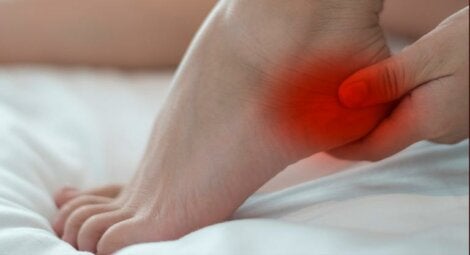Burning Feet Syndrome: Causes and Symptoms


Written and verified by the psychologist Valeria Sabater
Burning feet syndrome, also known as Grierson-Gopalan syndrome, is nighttime torture for those who suffer from it. Pain that shoots up to the ankles, tingling, and a burning sensation that makes it feel as if you’re walking on hot coals… This condition can make life difficult for those who deal with it every night.
This problem might remind you somewhat of another disorder that affects people at night and can affect their quality of life. We’re talking, of course, about restless legs syndrome. While it’s true that both problems are of neuropathic origin, they have their differences.
We know, for example, that burning feet syndrome is more common among women and people with diabetes. Cyclists also tend to suffer more from it than the general population.
Some nuances make this a very unique syndrome. Let’s learn more, shall we?

Burning feet syndrome: symptoms, causes, and treatment
Burning feet syndrome can come and go. Sometimes, the symptoms are more intense, while they may disappear completely at other times. The symptoms are variable because there’s a broad range of potential causes.
It’s important to note that this condition is rarely seen on its own. In general, it appears with other issues such as thyroid problems, joint pain, and general weakness, among others. People usually seek help for it, however, due to how bothersome the symptoms are and the negative effect it has on sleep.
Symptoms
The most common symptom is, unsurprisingly, a burning sensation that goes from the soles of the feet to the calves. Many people have to submerge their feet and calves into cold water for relief.
What causes burning feet syndrome?
Studies such as this one conducted by the Department of Neurology at University Hospital Muenster provide some interesting insights into this condition. Research shows that burning feet syndrome is an autosomal trait. In other words, it’s inherited. If someone in your family has it, you’re more likely to suffer from it.
- In most cases, the origin of the syndrome is neuropathy or an alteration in small nerve fibers. As a result of that alteration, the nervous system sends pain signals to the feet. This is a condition that comes and goes, and, as we mentioned above, affects women more than men.
- Another triggering factor is vitamin B12 deficiency. Not getting enough vitamin B12 can cause problems in your nervous system. The first signs are a tingling feeling and burning sensation in your arms and legs.
- Metatarsalgia or compression of the metatarsal bones is another common cause. This is a common problem for cyclists.
- Thyroid problems. Burning feet syndrome is also a common symptom for people with hypothyroidism.
- Nutritional absorption deficiency. If an individual has intestinal issues or is an alcoholic, they might get burning feet syndrome.
- Diabetes mellitus. Type 1 and 2 diabetes can affect the peripheral nerves of the body, especially those of the feet and legs. This is due to an elevated level of glucose in the blood, which alters the transmission of signals between nerves as well as blood vessel resistance.
How is it diagnosed?
As you can see, a variety of problems can potentially trigger burning feet syndrome. So how do doctors make a proper diagnosis? How do they figure out what’s causing this condition? Here are some of the most common diagnostic tests:
- Physical exam. The doctor will explore the affected area looking for swelling, joint problems, allergic reactions, etc.
- Blood tests. They’ll want to measure glucose levels as well as look for vitamin B12 deficiency and thyroid problems.
- They might also do tests to look at how your nervous system is functioning (i.e. an electromyogram). It measures the electrical activity of your muscles.

Treatments
Medical interventions for burning feet syndrome vary depending on the cause. However, some basic recommendations can help in most cases.
In conclusion, the best thing to do, even if you believe you know what’s causing your condition, is to see your doctor for a proper diagnosis. Always see a doctor before trying any home remedies.
Burning feet syndrome, also known as Grierson-Gopalan syndrome, is nighttime torture for those who suffer from it. Pain that shoots up to the ankles, tingling, and a burning sensation that makes it feel as if you’re walking on hot coals… This condition can make life difficult for those who deal with it every night.
This problem might remind you somewhat of another disorder that affects people at night and can affect their quality of life. We’re talking, of course, about restless legs syndrome. While it’s true that both problems are of neuropathic origin, they have their differences.
We know, for example, that burning feet syndrome is more common among women and people with diabetes. Cyclists also tend to suffer more from it than the general population.
Some nuances make this a very unique syndrome. Let’s learn more, shall we?

Burning feet syndrome: symptoms, causes, and treatment
Burning feet syndrome can come and go. Sometimes, the symptoms are more intense, while they may disappear completely at other times. The symptoms are variable because there’s a broad range of potential causes.
It’s important to note that this condition is rarely seen on its own. In general, it appears with other issues such as thyroid problems, joint pain, and general weakness, among others. People usually seek help for it, however, due to how bothersome the symptoms are and the negative effect it has on sleep.
Symptoms
The most common symptom is, unsurprisingly, a burning sensation that goes from the soles of the feet to the calves. Many people have to submerge their feet and calves into cold water for relief.
What causes burning feet syndrome?
Studies such as this one conducted by the Department of Neurology at University Hospital Muenster provide some interesting insights into this condition. Research shows that burning feet syndrome is an autosomal trait. In other words, it’s inherited. If someone in your family has it, you’re more likely to suffer from it.
- In most cases, the origin of the syndrome is neuropathy or an alteration in small nerve fibers. As a result of that alteration, the nervous system sends pain signals to the feet. This is a condition that comes and goes, and, as we mentioned above, affects women more than men.
- Another triggering factor is vitamin B12 deficiency. Not getting enough vitamin B12 can cause problems in your nervous system. The first signs are a tingling feeling and burning sensation in your arms and legs.
- Metatarsalgia or compression of the metatarsal bones is another common cause. This is a common problem for cyclists.
- Thyroid problems. Burning feet syndrome is also a common symptom for people with hypothyroidism.
- Nutritional absorption deficiency. If an individual has intestinal issues or is an alcoholic, they might get burning feet syndrome.
- Diabetes mellitus. Type 1 and 2 diabetes can affect the peripheral nerves of the body, especially those of the feet and legs. This is due to an elevated level of glucose in the blood, which alters the transmission of signals between nerves as well as blood vessel resistance.
How is it diagnosed?
As you can see, a variety of problems can potentially trigger burning feet syndrome. So how do doctors make a proper diagnosis? How do they figure out what’s causing this condition? Here are some of the most common diagnostic tests:
- Physical exam. The doctor will explore the affected area looking for swelling, joint problems, allergic reactions, etc.
- Blood tests. They’ll want to measure glucose levels as well as look for vitamin B12 deficiency and thyroid problems.
- They might also do tests to look at how your nervous system is functioning (i.e. an electromyogram). It measures the electrical activity of your muscles.

Treatments
Medical interventions for burning feet syndrome vary depending on the cause. However, some basic recommendations can help in most cases.
In conclusion, the best thing to do, even if you believe you know what’s causing your condition, is to see your doctor for a proper diagnosis. Always see a doctor before trying any home remedies.
All cited sources were thoroughly reviewed by our team to ensure their quality, reliability, currency, and validity. The bibliography of this article was considered reliable and of academic or scientific accuracy.
- Ravinder PSM, Anju A, Amitabh M, Ajay KG, Surabhi M, Burning Feet síndrome. Clinical Practice. Australian Family Physician; 2002;31:1006-9.
- Peralta M. El complejo sintomático de Madrid: síndrome parestésico causálgico. Revista Clínica Española. 1947;26:225-244.
- Stögbauer F, Young P, Kuhlenbäumer G, Kiefer R, Timmerman V, Ringelstein EB, Wang J F, Schröder JM, Van Broeckhoven C, Weis J. Autosomal dominant burning feet síndrome. J Neurol Neurosurg Psychiatry. 1999;67:78-81.
This text is provided for informational purposes only and does not replace consultation with a professional. If in doubt, consult your specialist.







